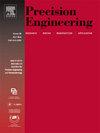基于迭代学习控制的自由曲面超精密金刚石车削无模型刀轨修正
IF 3.5
2区 工程技术
Q2 ENGINEERING, MANUFACTURING
Precision Engineering-Journal of the International Societies for Precision Engineering and Nanotechnology
Pub Date : 2025-04-04
DOI:10.1016/j.precisioneng.2025.04.003
引用次数: 0
摘要
借助商用超精密机床,刀具伺服金刚石车削工艺提供稳定、确定性的材料去除,满足高端自由曲面光学大批量生产的需求。然而,在相对高速的应用中,加工精度受到重型伺服轴的限制,即使在- 3db的工作带宽内。因此,为了促进工业采用金刚石车削,具有成本效益和用户友好的编程策略对于提高商用机床的运动精度至关重要。本文提出了一种基于迭代学习控制(ILC)的无模型刀轨修正策略,该策略基于伺服轴的误差数据迭代调整刀轨幅度。通过将基于几何的刀具轨迹与伺服轴的动态特性对齐,这种调整减少了高速应用中由基于频率的相位滞后和幅度变化效应引起的跟踪误差。此外,该策略消除了对额外复杂设备或模型识别的需要,使其非常适合工业应用。本文首先介绍了该方法的基本原理,然后证明了该方法的收敛性。通过轨迹跟踪和金刚石车削进行了一系列验证实验。实验结果表明,采用该策略,轨迹跟踪的峰谷误差降低约60%,均方根误差降低约80%。在正弦网格表面的金刚石车削实验中,形状误差从903 nm显著减小到527 nm。进一步的实验证实了基于ilc的刀具轨迹修改策略在高速应用中的长期有效性,为工业应用提供了有价值的见解。本文章由计算机程序翻译,如有差异,请以英文原文为准。

Model-free tool path modification in ultra-precision diamond turning of freeform surfaces using iterative learning control
With the aid of the commercial ultra-precision machine tool, the tool servo diamond turning process provides stable and deterministic material removal, meeting the demands for mass production of high-end freeform surface optics. However, in relatively high-speed applications, the machining accuracy is limited by the heavy servo axes, even within the working bandwidth of −3 dB. Therefore, to facilitate the industrial adoption of diamond turning, a cost-effective and user-friendly programming strategy is essential for enhanced motion accuracy in commercial machine tools. This work proposes a model-free tool path modification strategy using iterative learning control (ILC), which adjusts tool path amplitude iteratively based on the error data of servo axes. By aligning the geometry-based tool path with the dynamic properties of the servo axes, such adjustments reduce tracking errors caused by frequency-based phase lag and amplitude variation effects in high-speed applications. Additionally, this strategy eliminates the need for additional complex equipment or model identification, making it well-suited for industrial applications. The fundamental principle of the proposed method is first presented, followed by a demonstration of its convergence. A series of validation experiments are conducted through trajectory tracking and diamond turning. Experimental results indicate that trajectory tracking achieves a reduction of approximately 60 % in peak-to-valley error and about 80 % in root-mean-square error with the proposed strategy. For diamond turning experiments on sinusoidal grid surfaces, the form error is significantly reduced from 903 nm to 527 nm. Further experiments confirm the long-term effectiveness of the ILC-based tool path modification strategy in high-speed applications, offering valuable insights for industrial use.
求助全文
通过发布文献求助,成功后即可免费获取论文全文。
去求助
来源期刊
CiteScore
7.40
自引率
5.60%
发文量
177
审稿时长
46 days
期刊介绍:
Precision Engineering - Journal of the International Societies for Precision Engineering and Nanotechnology is devoted to the multidisciplinary study and practice of high accuracy engineering, metrology, and manufacturing. The journal takes an integrated approach to all subjects related to research, design, manufacture, performance validation, and application of high precision machines, instruments, and components, including fundamental and applied research and development in manufacturing processes, fabrication technology, and advanced measurement science. The scope includes precision-engineered systems and supporting metrology over the full range of length scales, from atom-based nanotechnology and advanced lithographic technology to large-scale systems, including optical and radio telescopes and macrometrology.

 求助内容:
求助内容: 应助结果提醒方式:
应助结果提醒方式:


